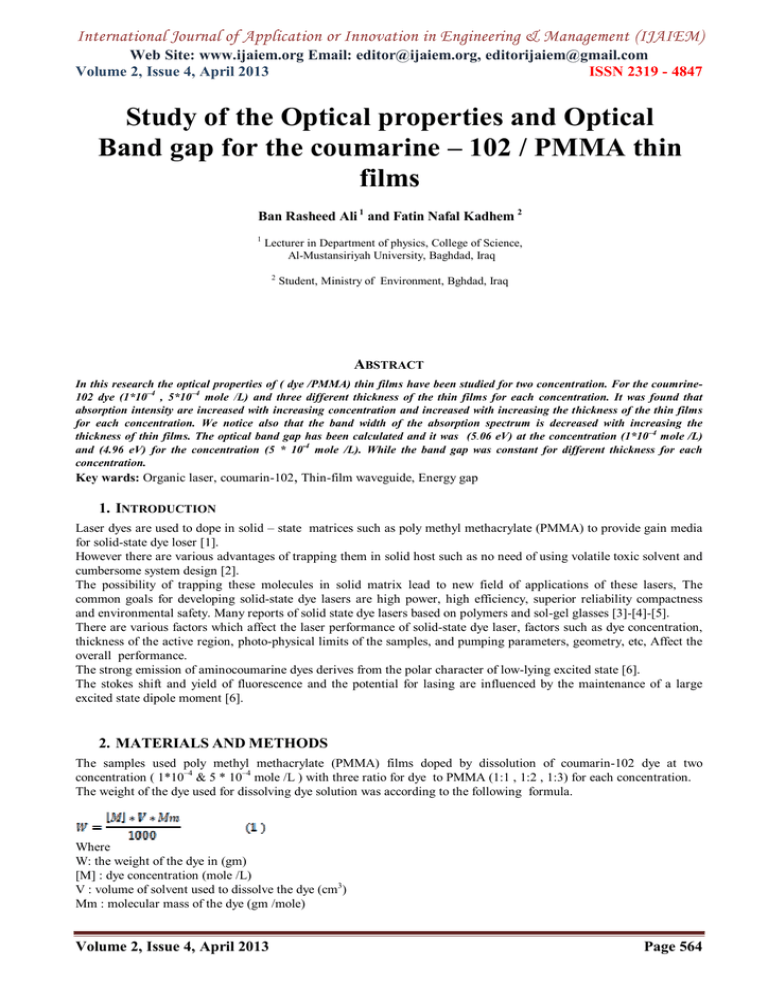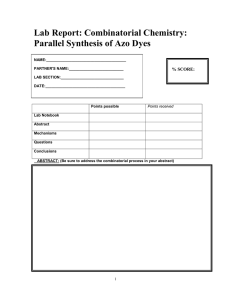Study of the Optical properties and Optical films
advertisement

International Journal of Application or Innovation in Engineering & Management (IJAIEM) Web Site: www.ijaiem.org Email: editor@ijaiem.org, editorijaiem@gmail.com Volume 2, Issue 4, April 2013 ISSN 2319 - 4847 Study of the Optical properties and Optical Band gap for the coumarine – 102 / PMMA thin films Ban Rasheed Ali 1 and Fatin Nafal Kadhem 2 1 Lecturer in Department of physics, College of Science, Al-Mustansiriyah University, Baghdad, Iraq 2 Student, Ministry of Environment, Bghdad, Iraq ABSTRACT In this research the optical properties of ( dye /PMMA) thin films have been studied for two concentration. For the coumrine102 dye (1*10–4 , 5*10–4 mole /L) and three different thickness of the thin films for each concentration. It was found that absorption intensity are increased with increasing concentration and increased with increasing the thickness of the thin films for each concentration. We notice also that the band width of the absorption spectrum is decreased with increasing the thickness of thin films. The optical band gap has been calculated and it was (5.06 eV) at the concentration (1*10–4 mole /L) and (4.96 eV) for the concentration (5 * 10-4 mole /L). While the band gap was constant for different thickness for each concentration. Key wards: Organic laser, coumarin-102, Thin-film waveguide, Energy gap 1. INTRODUCTION Laser dyes are used to dope in solid – state matrices such as poly methyl methacrylate (PMMA) to provide gain media for solid-state dye loser [1]. However there are various advantages of trapping them in solid host such as no need of using volatile toxic solvent and cumbersome system design [2]. The possibility of trapping these molecules in solid matrix lead to new field of applications of these lasers, The common goals for developing solid-state dye lasers are high power, high efficiency, superior reliability compactness and environmental safety. Many reports of solid state dye lasers based on polymers and sol-gel glasses [3]-[4]-[5]. There are various factors which affect the laser performance of solid-state dye laser, factors such as dye concentration, thickness of the active region, photo-physical limits of the samples, and pumping parameters, geometry, etc, Affect the overall performance. The strong emission of aminocoumarine dyes derives from the polar character of low-lying excited state [6]. The stokes shift and yield of fluorescence and the potential for lasing are influenced by the maintenance of a large excited state dipole moment [6]. 2. MATERIALS AND METHODS The samples used poly methyl methacrylate (PMMA) films doped by dissolution of coumarin-102 dye at two concentration ( 1*10–4 & 5 * 10–4 mole /L ) with three ratio for dye to PMMA (1:1 , 1:2 , 1:3) for each concentration. The weight of the dye used for dissolving dye solution was according to the following formula. Where W: the weight of the dye in (gm) [M] : dye concentration (mole /L) V : volume of solvent used to dissolve the dye (cm3) Mm : molecular mass of the dye (gm /mole) Volume 2, Issue 4, April 2013 Page 564 International Journal of Application or Innovation in Engineering & Management (IJAIEM) Web Site: www.ijaiem.org Email: editor@ijaiem.org, editorijaiem@gmail.com Volume 2, Issue 4, April 2013 ISSN 2319 - 4847 Acetone was used as a common solvent for the dye and PMMA. The film–forming solution of dye /PMMA were kept in a Petridis and the solvent is allowed to evaporate at room temperature. The whole system was kept in a dust – free environment. In this method the thickness of the film can be adjusted by the concentration and the volume of the polymer solution. Absorption spectrum was measured by (UV-VIS spectrophotometer sp–3000 plus), this device operates within the range (200–1100 nm) of the visible and ultraviolet region. Polymer films thickness was measured by using a Japanese aperture. (MITUToyo) which is measured the thickness of the films ranging between (0-25 mm). The materials used in this search without further purification. Coumarine dye laser (C-102) supplied from Lambda physics has a molecular mass (255.31 gm/mole), molecular formula ( C16 H17 NO2 ) and it can be dissolve In Ethanol, Methanol, Benzene, Acetone, etc. [7]. The structural formula is [8]. CH3 N O O Poly methyl methacrylate (PMMA) Polymer from (fluka. A. G.) have a molecular formula (CH3C(CH3)COOCH3), molecular mass ( 8400 gm/mole). Melting degree (213 °C), density ( 1.19 gm/cm3) and refractive index (1.5). The solvent used in this search was Acetone from (American Thomas baker com.) with purity ( 99.9%), molecular formula (CH3COCH3) and its scientific name is 2-propanon molecular mass (58.08 gm/mole), Polarity (0.68) and refractive index (1.3588). 3. RESULT AND DISCUSSION The absorption spectrum for coumarin-102 dye loser which dissolved in Acetone solvent and doped in PMMA as a host was measured and studied in this search as a function of concentration and thin films thickness. Fig.(1) and Fig.(2) are the absorption spectrum for two concentration (1*10-4 and 5*10–4mole/L) respectively. We notice from these figures that the increase in molar concentration lead to increase in the intensity of absorption and the increase in the film thickness led to increase in the intensity of absorption for each concentration which increases according to Beer – lambert law .Such that the increase in the molecular concentration consequently lead to increase in the absorbance [9]. Fig. (1): The absorptance of the thin films as a function of wavelength. Volume 2, Issue 4, April 2013 Page 565 International Journal of Application or Innovation in Engineering & Management (IJAIEM) Web Site: www.ijaiem.org Email: editor@ijaiem.org, editorijaiem@gmail.com Volume 2, Issue 4, April 2013 ISSN 2319 - 4847 Fig. (2): The absorptance of the thin films as a function of wavelength. And this satisfy agreement with the reported research [8]-[10]. The band width of the absorption spectrum are increased with increasing concentration and decrease with increasing film thickness for each concentration. The number of laser modes is limited by the stimulated emission band width and the number of laser modes are increased with the increasing film thickness [11]. The data from absorption spectrum can be used in the calculation of the optical constants. A computer program (excel) was employed to obtain the optical constant, absorption coefficient (α), the allowed and forbidden band gap for the dye/PMMA films [12]. From figs. (3,4) we find the allowed band gap (e.g) by plotting the variation of (αhv)2 with photon Energy (hv) of the (dye/PMMA) films by using the equation. (2) α :absorption coefficient in cm-1 hv: photon energy (eV) : constant depend on the type of transitions. eg: energy gap in (eV) r: constant its value depends on the transition nature where r=1/2 for allowed direct transition and r=3/2 for bidden direct transition [13]. The absorption coefficient (α) has been calculated by using to equation (3) . (3) A = is the absorption at a certain wavelength. d: is the thickness of the films. (a) Volume 2, Issue 4, April 2013 Page 566 International Journal of Application or Innovation in Engineering & Management (IJAIEM) Web Site: www.ijaiem.org Email: editor@ijaiem.org, editorijaiem@gmail.com Volume 2, Issue 4, April 2013 ISSN 2319 - 4847 (b) (c) Fig. (3): Shows the allowed direct band gap at concentration (1*10–4 mole /L), for (a) d=0.048 mm (b) d= 0.074 mm (c) d=0.117 mm. (a) Volume 2, Issue 4, April 2013 Page 567 International Journal of Application or Innovation in Engineering & Management (IJAIEM) Web Site: www.ijaiem.org Email: editor@ijaiem.org, editorijaiem@gmail.com Volume 2, Issue 4, April 2013 ISSN 2319 - 4847 (b) (c) Fig. (4): Shows the allowed direct band gap at concentration (5*10–4 mole /L), for (a) d=0.025 mm (b) d= 0.08 mm (c) d=0.144 mm. The allowed band gap was (5.06 eV) at the concentration (1*10-4 mole /L) and (4.96 eV) at concentration (5*10-4 mole/L) Also the forbidden direct gap was calculated by plotting the relation (αhv) 2/3 with the photon energy (hv) as illustrated in figs. (5,6) and it was (5.06 eV) at the concentration (1*10-4 mole /L) and (4.96 eV) for the concentration (5*10-4 mole /L). The values of band gap were constant with different thickness for the same concentration. (a) Volume 2, Issue 4, April 2013 Page 568 International Journal of Application or Innovation in Engineering & Management (IJAIEM) Web Site: www.ijaiem.org Email: editor@ijaiem.org, editorijaiem@gmail.com Volume 2, Issue 4, April 2013 ISSN 2319 - 4847 (b) (c) Fig. (5): Shows the forbidden direct band gap at concentration (1*10-4 mole /L) for (a) d=0.048 mm (b) d= 0.074 mm (c) d=0.117mm. (a) Volume 2, Issue 4, April 2013 Page 569 International Journal of Application or Innovation in Engineering & Management (IJAIEM) Web Site: www.ijaiem.org Email: editor@ijaiem.org, editorijaiem@gmail.com Volume 2, Issue 4, April 2013 ISSN 2319 - 4847 (b) (c) Fig. (6): Show the forbidden direct band gap at concentration (5*10-4 mole /L) for (a) d= 0.25 mm (b) d= 0.08mm (c) d= 0.144mm. Table (1): The absorption spectrum properties. Con. Mole/ L 1*10-4 1*10-4 1*10-4 5*10-4 5*10-4 5*10-4 Ratio of dye/PMMA 1:1 1:2 1:3 1:1 1:2 1:3 d mm Imax (a. u.) 0.048 0.074 0.117 0.025 0.08 0.144 0.284 0.337 0.565 1.071 0.45 0.977 mm 59 58 57 61 60 57 References [1] F.J. Durate, “ Tunable Laser optics”, E1sevier-Academic, New York, ( 2003). [2] Aparna V., Ebinazar B., “ Correlation between lasing and photo physical Performance of dyes in Polymethlmthaerylate”, J. of Luminescence al, 25-31, (2000). [3] K. H. Drexhage “ Dye lasers, topics in Applied physics“, Vol.1 ed. F.P. Schafer, springer verlagy New York, ch 4, ( 1973 ). [4] F. P. Schafer et al, “ organic dye solution laser”, App. Phys. Let., 9 (8) , 306, (1966). Volume 2, Issue 4, April 2013 Page 570 International Journal of Application or Innovation in Engineering & Management (IJAIEM) Web Site: www.ijaiem.org Email: editor@ijaiem.org, editorijaiem@gmail.com Volume 2, Issue 4, April 2013 ISSN 2319 - 4847 [5] [6] [7] [8] F. Amat Guerri, A. Costela, J. M. Figuera, F. florid, chem. phys. Lett 209, 352, (1993). L. Lopez Arbeloa, T. Lopez-Arbeloa A. costela, I. Garcia-Moreno, Appl. Phys. B 64, 651, (1997). Organic Electronic materials Vol. 5, No. 8, http: www.sigmaldrich.com, Aldrich brochure, (2005). H. F. Sa’adalla, “spectroscopic properties of polymer film dopped by dye laser organic type (C 102)”, Master thesis, ch. (4), collage of sciences, Al-Mustansiriyah University, (2007). [9] Yaqoob M. Jwad, “ study the effect on concentration and solvent polarity on 1-Naphthylamine quantum efficiency”, Master thesis, Ch 4, collage of science , Al-Mustansiriyah University, (2011). [10] H. K. Saeso, “ spectral study of polymeric R 110 Thin films”, Master thesis, ch4, collage of science, AlMustansiriyah University, (2011). [11] Vincent D. et.al, “ polymer thin film distributed feed distributed feedback tunable lasers”, J. opt. A: pure Appl. Opt. 2, 279-283, U.K, (2000). [12] Huda J. A., “ The electrical and optical properties of annealed (d2 SnO4, thin films prepared by chemical spray pyrolysis technique”, master thesis, Ch2,. collage of science, Al-Mustansiriyah University, (2010). [13] J. I. Pankove, “ Optical Process in semiconductors”, Dover published. Inc., New York, (1971). AUTHOR Dr. Ban Rasheed Ali received the M.S. degrees and Ph. degree in Physics from Al-Mustansiriyah University in 1995 and 2003, respectively. Fatin Nafal Kadhem received the B.S.c in physics from Al-Mustansiriyah University in 1999,. During 2000-2010, she work in Ministry of Environment, climate change center. She now study master of science in physics, solid state. Volume 2, Issue 4, April 2013 Page 571



